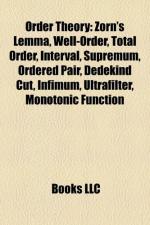|
This section contains 647 words (approx. 3 pages at 300 words per page) |

|
Real analysis, which studies the theoretical foundations of the calculus of real-valued functions, depends upon an accurately defined real number concept. Such a precise definition eluded mathematicians from the time ofPythagoras (c.560-c.480BC) to the latter half of the nineteenth century. The problem was not with all real numbers, but with that subset of the reals known as the irrational numbers. Pythagoras, it is said, was so horrified by the appearance of the irrational number 2, i.e., the positive square root of 2, in his calculation of the hypotenuse of a right triangle that he swore his followers to secrecy on the matter. The Pythagoreans called such numbers "incommensurable" because they could not be obtained by multiplying two rational numbers together. A rational number can always be expressed as the quotient of two integers--that's the definition of a rational number--but these "incommensurables" cannot be expressed in...
|
This section contains 647 words (approx. 3 pages at 300 words per page) |

|


